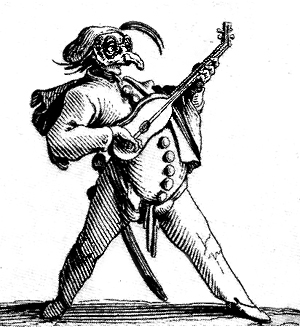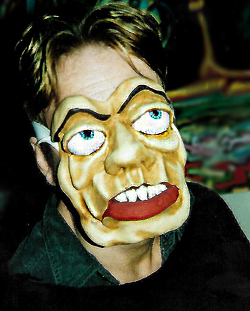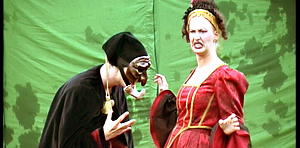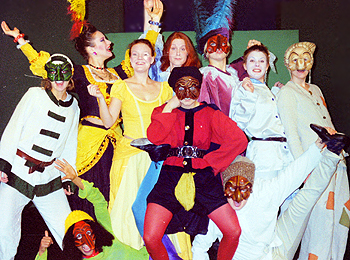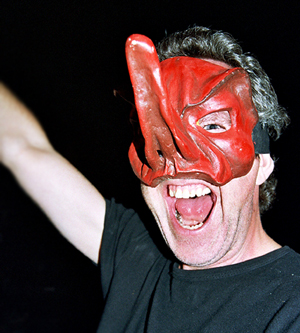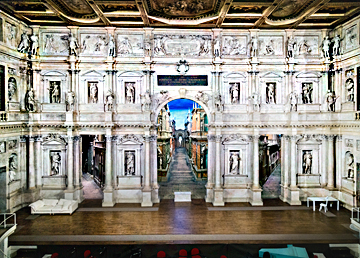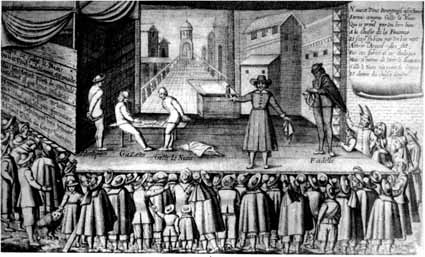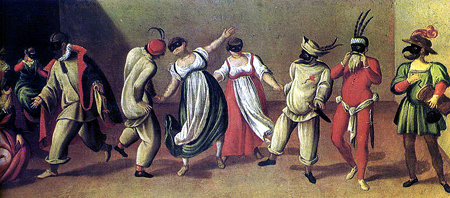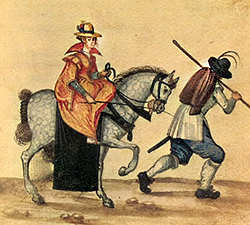
What we will be looking at are the actors from the most famous Commedia dell’Arte groups of its time. It is also those actors we have most and most interesting information about. Let us not believe that they are representative for al Commedia dell’Arte groups from the time. That would be like studying that Rolling Stones or Lady Gaga to learn about the general music scene today, or that Broadway or European royal institutions would be representative for today’s theatre just because it is what the media writes about. Neither are there any evidence that they would be better than their less fortunate colleagues.
Here is a list of actors of some of the most famous actors from the middle of the sixteenth century to the middle of the seventeenth century:
Here is a list of actors of some of the most famous actors from the middle of the sixteenth century to the middle of the seventeenth century:
- Andrea Frajacomi da Bologna Uniti Trivellino
- Andrea Mangini da Genoa Uniti Adriano
- Adriano Valerini da Verona Gelosi Aurelio
- Antonella Bajardi Gelosi Vittoria (The role that Vittoria Piissimi created)
- Batta Fiorillo Uniti Scaramuzza, at least from 1614.
- Battista da Treviso Uniti Franceschina, 1584
- Domenico Bruni Gelosi, Confidenti Innamorato
- Drusiano Martinelli Confidenti , Uniti, Accesi Arlecchino, capocomicofrom 1587. He was also Tristanos older brother. He also travelled to England 1570 with his wife Angelica.
- Girolamo Fiorillo Uniti Innamorato
- Diana Ponti Desiosi, Uniti Innamorata och capocomico in Desiosi
- Domenico Biancolelli the Fiorelli company Arlecchino
- Flaminio Scala Gelosi, Confidenti, Accesi and Desiosi. He was Innamorato and capocomico for Gelosi and Confidenti. He was Gelosis first leader. We don’t know when he abdicated to Francesco Andreini, but it was after that he joined, and sometimes led, other groups. He also wrote the first printed collection of scenari, Il Teatro della Favole Rappresentative in1611 and Le Bravure del Capitano Spavento in 1607.

- Francesco Andreini Gelosi Innamorato, Capitano, Dottore, and more. He was for the longest time Gelosi’s undisputed leader. He was faithful to Gelosi and dispended the company and quit acting when his wife Isabella died in 1604.
- Francesco Gabrielli Confidenti, Uniti, Fedeli Scapino
- Gabrielo Panzanini Gelosi Franca Trippa
- Girolamo Salimboni da Firenze Gelosi ZanobioFedeli
- Giovan Battista Andreini Fedeli, Gelosi Innamorato, Arlecchinooch capocomico. The son of Francesco and Isabella
- Giovanni Gabrielli On his own Charlatano The father of Francesco Gabrielli
- Giovanni Pellesini Accesi, Uniti, Fedeli Pedrolino
- Giulio Pasquati da Vicenza Gelosi Pantalone
- Isabella Andreini Gelosi (Uniti, Confidenti) Innamorata and primadonna or Isabella, the role she created herself and wish got her name. She was Commedia dell’Arte’s and the sixteenth century’s mega star.
- Jacomo Braga da Ferrara Uniti Pantalone
- Lidia de Bagnacavallo Gelosi Innamorata
- Luigi Riccoboni His own company Innamorato
- Ludovico da Bologna Gelosi Dottore
- Molière No futher explanation needed
- Nicolo Barbieri Confidenti, Fedeli Beltrame
- Ottavio Bernardino da Roma Uniti Franceschina
- Orazio Nobili Gelosi Innamorato
- Orsola Cecchini Accesi Innamorata
- Pier Maria Cecchini Accesi Fritellinoand capocomicoHe seem to be known for being a selfish leader and hard to work with
- Ricci Frederigo Accesi Pantalone
- Ricci Frederigos son Accesi Innamorato
- Silvia Roncagli da Bergamo Gelosi Franceschina och Lesbino
- Silvio Fiorillo da Napoli Uniti, Accesi, Desiosi Capitano Matamoros
- Simone da Bologna Gelosi Arlecchino
- Tiberio Fiorilli the Fiorelli company Scaramuccia och capocomico Probably son to Silvio Fiorillo
- Tristano Martinelli Confidenti , Accesi, Desiosi Arlecchino and later capocomico He wrote Compositions de Rhetorique in 1601. It can also be he who ”invented” Arlecchino.
- Vittoria Piissimi Gelosi, Uniti, Confidenti, Innamorata and probably Gelosi’s firs primadonna capocomica. Her stardom was probably gradually overtaken by Isabella Andreini, who joined the group about 1578, 16 years old.
- Virginia Ramponi/Andreini Fedeli Innamorata, Giovan Battistas fist wife
- Virginia Rotari/Andreini Fedeli Innamorata, Giovan Battistas second wife
- Zan Ganassa With his own company Second Zanni and capocomicoHe and his group was the first we know the name of, but apart from that we don’t know very much.
See also:
What we really know about Commedia dell’Arte
Theories of Laughter and Comedy
About Micke’s Workshops and lectures
